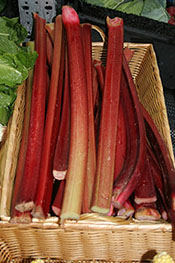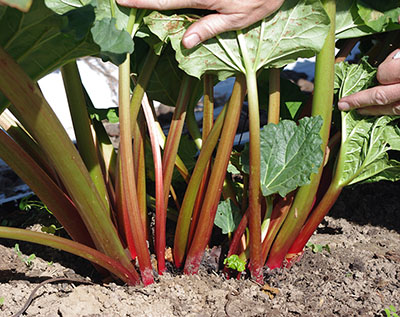Rhubarb
Rhubarb (Rheum rhabarbarum) is a winter-hardy herbaceous perennial grown for its edible leaf stalks. The tart-flavored stalks are most commonly used in pies, often in combination with strawberries for added sweetness. The leaves themselves are not eaten, either cooked or raw, as they contain toxic levels of oxalic acid.
Marketing
 Fresh market options for Kentucky-grown rhubarb include direct markets, especially farmers markets, on-farm markets, Community Supported Agriculture, and roadside stands. There is wholesale market potential for rhubarb, especially at local grocery stores and restaurants. Some producers add rhubarb to value-added products including pies, sweet breads, fruit cups (mixed with strawberries), jams/jellies, and candy-type products. Rhubarb is also used in winemaking. Rhubarb is a vegetable crop used as a fruit, and it has the advantage of being harvestable in early summer when most fruits are not yet ripe. Although a cool-season crop, rhubarb can last far into the summer and provide variety at a farmers market or roadside stand.
Fresh market options for Kentucky-grown rhubarb include direct markets, especially farmers markets, on-farm markets, Community Supported Agriculture, and roadside stands. There is wholesale market potential for rhubarb, especially at local grocery stores and restaurants. Some producers add rhubarb to value-added products including pies, sweet breads, fruit cups (mixed with strawberries), jams/jellies, and candy-type products. Rhubarb is also used in winemaking. Rhubarb is a vegetable crop used as a fruit, and it has the advantage of being harvestable in early summer when most fruits are not yet ripe. Although a cool-season crop, rhubarb can last far into the summer and provide variety at a farmers market or roadside stand.
Production
 Rhubarb is a cool-season crop, thriving on a well-drained soil that is deep and high in organic matter. Fields should be free of perennial weed problems and deeply plowed. Applications of aged manure are very beneficial to rhubarb. Plantings are established vegetatively from vigorous, disease-free crown pieces, each with two or more buds. Rhubarb should be transplanted in early March in Kentucky. Rhubarb seed does not produce plants true to the parent, so direct seeding is not recommended. Traditionally, plantings were rejuvenated every eight to 10 years by dividing crowns and resetting; however, it is now difficult to get rhubarb plantings to last this long because of disease, so research is underway to develop an annual production system.
Rhubarb is a cool-season crop, thriving on a well-drained soil that is deep and high in organic matter. Fields should be free of perennial weed problems and deeply plowed. Applications of aged manure are very beneficial to rhubarb. Plantings are established vegetatively from vigorous, disease-free crown pieces, each with two or more buds. Rhubarb should be transplanted in early March in Kentucky. Rhubarb seed does not produce plants true to the parent, so direct seeding is not recommended. Traditionally, plantings were rejuvenated every eight to 10 years by dividing crowns and resetting; however, it is now difficult to get rhubarb plantings to last this long because of disease, so research is underway to develop an annual production system.

